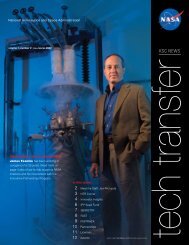2006-2007 - Kennedy Space Center Technology Transfer Office
2006-2007 - Kennedy Space Center Technology Transfer Office
2006-2007 - Kennedy Space Center Technology Transfer Office
- No tags were found...
Create successful ePaper yourself
Turn your PDF publications into a flip-book with our unique Google optimized e-Paper software.
Trajectory Model of Lunar Dust ParticlesThe goal of this work was to predict the trajectories of blowing lunar regolith (soil)Site Preparation particles when a spacecraft lands on or launches from the Moon. The blown regolith isand Excavation known to travel at very high velocity and to damage any hardware located nearby on theMoon. It is important to understand the trajectories so we can develop technologies tomitigate the blast effects for the launch and landing zones at a lunar outpost. A mathematical modelwas implemented in software to predict the trajectory of a single spherical mass acted on by the gasjet from the nozzle of a lunar lander. As initial conditions, the trajectory calculation uses the particlediameter D and initial position of the particle r 0= (x 0, y 0, z 0), where the vertical direction x is positiveup and equal to zero at the surface. Typically, the user sets the particle’s starting position above thesurface as x 0= D/2.The model uses an input file that contains data for the forces created by high-velocity gas flow. Themodel can use data in either of the following formats:Two-dimensional: Based on cylindrical symmetry, in this format, the problem is set up to beindependent of the azimuth angle. The two-dimensional data used in this project was created bycomputational fluid dynamics (CFD) software.Three-dimensional: The full three-dimensional case makes no assumption of symmetries. Threedimensionaldata was created with Direct Simulation Monte Carlo (DSMC) software, which usesprobabilistic simulation to solve the Boltzmann equation for fluid flows. Individual molecules aremoved through a simulation of physical space in a realistic manner that is directly coupled to physicaltime such that unsteady flow characteristics can be modeled. Intermolecular collisions and moleculesurfacecollisions are calculated by means of probabilistic, phenomenological models. The DSMCmethod assumes that the molecular movement and collision phases can be decoupled over periodsshorter than the mean collision time. Figures 1 and 2 show simulation model geometry on the lunarsurface with corresponding simulated craters.For a particle of diameter D and mass m,the trajectory from drag can be estimated bya Taylor series expansion about time pointk, resulting in a set of discrete-differenceequations for position and velocity, usingconstant lunar gravity g Land lunar soil particledensity r L. The CFD/DSMC output providesestimates of gas density r(r)and gas velocityu(r). These values are interpolated from theCFD/DSMC grid by the identification ofthe nearest grid neighbors around the kthtrajectory point and the application of anN-dimensional interpolation algorithm. SeeFigure 3.Figure 1. Three-dimensional simulation geometry with equal-size cratersat varying distances from the rocket blast center.The coefficient of drag, C D, is a function ofthe computed Reynolds number, R e. Liftacceleration caused by the vertical gradientof the horizontal component of gas flow isalso computed, with the use of an estimatedcoefficient of lift, C L. Since particle lift anddrag coefficients (especially lift) are unknownat these high Mach and rarefied flow42 <strong>Space</strong>port Structures and Materials













